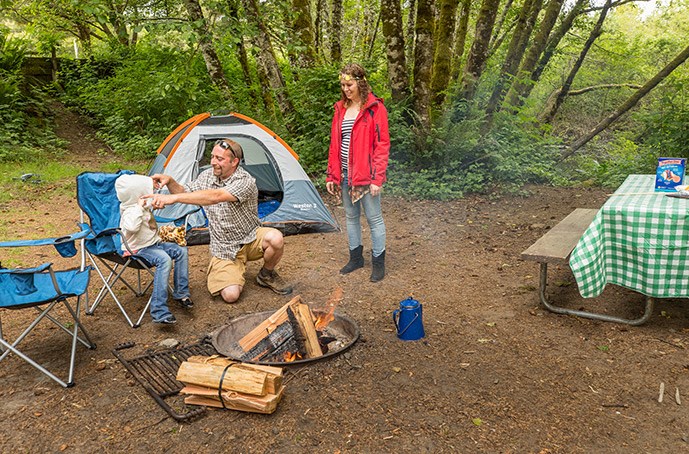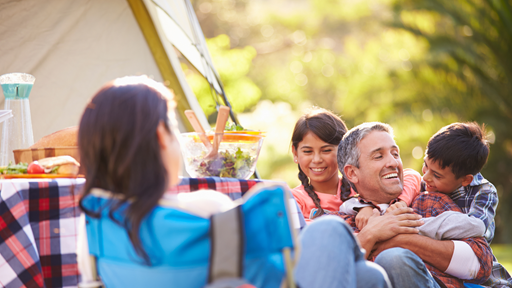Keep your camping trips safe and fun with our list of tips for safe camping.
You may be wondering if camping is safe, and it’s a completely understandable thing to wonder if you’re never been before.
While camping is an enjoyable activity, there are many tips to ensure your safety during a fun-filled weekend or adventurous week-long trip. Check out the following camping safety guide to learn more about how to make the most of your next campaign trip by keeping everyone safe and comfortable.
1. Choose the Right Shelter and Site
To reserve the right type of shelter and campground site, consider your age, physical limitations and medical needs — as well as those of everyone else in your group. Different amenities are available if you’re staying in a tent compared to a cabin or RV, so plan accordingly as to what gear you’ll need based on your site choice.
For example, camping in a cabin provides you with full beds and bunk beds, while sleeping in a tent will require you to bring an air mattress, sleeping bag or other accommodations.
Although RVs and cabins offer more amenities and safety compared to tents, about 60% of campers still report opting for tent camping. At KOA, we provide tent campers with picnic tables, fire rings, nearby restrooms with showers and a spacious area for your whole crew to hang out, relax and spend quality time together.
2. Stay Up-to-Date With the Weather
Make sure to keep an eye on the weather forecast before your trip. As we all know, weather can change within the hour, which means it’s essential to pack for inclement weather such as rain, snow, and high heat and humidity. About 33% of campers plan trips one month in advance to be proactive.
3. Pack and Store Food Safely
Leaving food out on picnic tables or anywhere not secured can increase your chances of attracting into wildlife. To prevent unwanted confrontations with an animal, pack your food in tight, waterproof containers and store them in an insulated cooler. To avoid food-borne illnesses, wash your hands and separate raw food from cooked meals. One in 6 Americans get sick from contaminated food every year, so make sure you’re following proper food safety practices.
4. Practice Campfire Safety
Fires within your campground site should be at least 15 feet from tent walls, shrubs and trees. It’s important to keep your fire small and contained in a designated area like a fire pit. You should also never leave a fire unattended. Always keep a water bucket nearby and put the fire out before leaving or going to sleep — making sure to drown all the embers, not just the red ones.
5. Use Insect Protection
To protect yourself from mosquitos, ticks and other insects, use insect repellent that doesn’t dissolve easily in water. Make sure you check for ticks daily, especially in unsuspecting areas of your body. It’s also recommended to wear long-sleeved shirts and long pants when hiking to avoid direct contact with insects. After a hike or any outdoor activity, place your clothes in the dryer for at least 10 min on high heat to kill any ticks that may have come home on your clothing.
6. Be Aware of Allergies
Packing an EpiPen or other medications for your known allergies is a smart way to prepare for any unexpected encounters. You should also keep a first aid kit handy and watch for dizziness, labored breathing and swelling around bites or places where plants or insects may have been in contact with your skin.
7. Protect Your Skin from the Sun
We often think UV rays are absent on cloudy days, but they can burn your skin just as severely as on a sunny day. Midday hours are when the sun’s rays are the strongest — seeking shade, wearing a hat or putting on sunglasses can help protect you from the UV rays. We recommend using a broad-spectrum sunscreen and lip screen with at least SPF 15.
8. Stay Hydrated
Staying hydrated doesn’t mean drinking when you’re thirsty — it means drinking water regularly throughout the day, even if you don’t think you’re thirsty. An emergency kit should include at least a 3- to 5-day supply of bottled water. If you feel thirsty, chances are you’re already dehydrated
9. Watch Out for Wildlife
Storing your food in a car, a bear-safe container or food storage locker can prevent attracting unwanted wildlife. Be sure to avoid touching and feeding animals — but if you do come in contact with any animals. wash your hands with soap and water or by using a hand sanitizer containing at least 60% alcohol.
10. Have Fun and Remain Alert
Camping in a fun experience, but it’s also imperative to pay attention to your body, what it needs and how it reacts to the environment. Keep your wits about you, get plenty of sleep and limit your alcohol intake. About 3.4 million U.S. households became new campers over last three years — enjoy your time outdoors and have fun with your fellow campers.
Camping at Kampgrounds of America
With the largest collection of private campgrounds reaching more than 500 locations across North America, Kampgrounds of America offers you an affordable vacation option. Whether you’re looking to stay in a Camping Cabin, Deluxe Cabin, RV, tent or other type of accommodation, our campgrounds are dedicated to people who enjoy spending time outdoors with friends and family. Every site has a laundry facility, playground, KOA store and bathrooms with hot water for your convenience.
Contact KOA to reserve a campsite and learn more about camping safety tips or how our passionate campground professionals can help you enjoy your camping experience. Make a reservation online or with our KOA Camping App today!


























